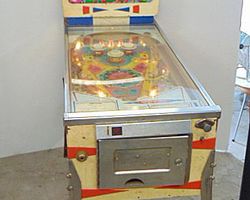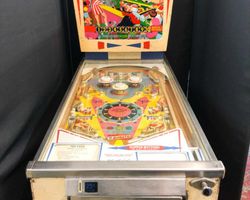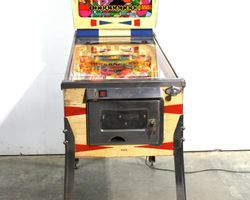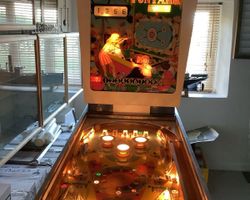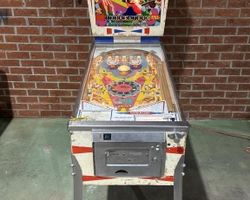Fun Park
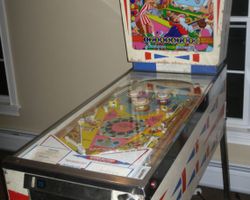
Average Prices: USD $400 to $900
Produced: August, 1968
Production Run: 580 units
Machine Type: Electro-mechanical
Players: 1
Design by: Ed Krynski, Steve Kirk
Art by: Art Stenholm
Pinball machines often transport players to vibrant, imaginative worlds, and the 1968 Gottlieb "Fun Park" is a prime example, immersing players in a lively carnival atmosphere. This electro-mechanical (EM) pinball machine, produced by D. Gottlieb & Co., captures the essence of a shooting gallery within an amusement park setting. It stands as a significant entry in Gottlieb’s prolific output, designed by Ed Krynski, with artwork by Art Stenholm, and a concept credited to Steve Kirk. Krynski, a prominent designer for Gottlieb, was responsible not only for the machine's overall design but also for its animation and mechanical aspects, showcasing a comprehensive involvement in its creation.
Released in August 1968, "Fun Park" was part of a limited production run, with only 580 units manufactured. This relatively modest production number contributes to its status as a sought-after piece among collectors and enthusiasts today. The machine’s identity is closely tied to its "Add-A-Ball" (AAB) mechanic, a feature that distinguishes it from its replay counterpart, "Fun Land," also released in 1968. While "Fun Land" awarded free games for achieving certain scores or objectives, "Fun Park" instead granted additional balls, extending gameplay and offering a different kind of challenge and reward system. This choice in feature set shaped its market impact, appealing to operators who valued longer player engagement per credit and players who appreciated extended play sessions.
Signature Features and Design
"Fun Park" is defined by its core gameplay innovations and an artistic vision that complements its theme. Foremost among its standout elements are the dual spinning targets, often referred to as "spinners." These mechanisms are not merely static targets; they dynamically react to ball contact, rotating vigorously and providing a satisfying tactile and auditory feedback loop for players. Successfully hitting these spinners is often integral to lighting scoring objectives and advancing game progress, making them central to the player experience. The mechanical satisfaction derived from a well-struck spinner became a hallmark for many Gottlieb machines of this era.
Beyond the spinners, the machine’s "Add-a-Ball" (AAB) feature is a defining characteristic. Instead of awarding free games, "Fun Park" grants players additional balls for reaching specific milestones or combinations of targets. This mechanic significantly alters the pace and strategy of gameplay, encouraging players to pursue objectives that extend their game time rather than just focusing on high scores for replays. The thrill of earning an extra ball, especially after a challenging sequence of shots, heightens engagement and provides a distinct incentive unique to AAB titles. The artwork, meticulously crafted by Art Stenholm, visually reinforces the carnival theme. The playfield and backglass are adorned with vibrant colors and caricatures reminiscent of a shooting gallery, featuring various targets and attractions one might find at an amusement park. This visual appeal, combined with the game's inviting layout, ensures that "Fun Park" possesses a strong aesthetic identity that draws players in.
Playfield and Mechanics
The "Fun Park" playfield layout exemplifies Gottlieb's design philosophy of the late 1960s, prioritizing clear shot objectives and a balanced flow. The symmetrical design guides player attention, presenting a harmonious blend of upper and lower playfield elements. Dominating the upper playfield are three pop bumpers, strategically placed to create chaotic, unpredictable ball movement, often leading to unexpected point accrual or directing the ball toward other targets. These bumpers, along with two slingshots situated above the flippers, contribute to the kinetic energy of the game.
Key to the playfield’s design are various targets that engage the player. Two prominent spinning targets are positioned in the upper-mid playfield, offering satisfying feedback upon contact. Alongside these, two standup targets are integrated into the layout, typically associated with specific scoring objectives. The "shooting gallery" theme is further enhanced by a series of numbered targets that players aim to light up sequentially. Completing these sequences often unlocks significant bonuses, including the coveted Add-a-Ball awards or high-value point awards. The playfield flow encourages players to cycle the ball through the upper regions to activate bumpers and spinners, then recover and aim for the lower targets from the two standard flippers.
The artwork on the playfield reinforces the carnival theme with bright, bold illustrations of various shooting gallery elements, prizes, and attendees. This colorful aesthetic is complemented by the machine’s lighting, which guides players to active targets and illuminates achieved objectives. The mechanical reels, standard for an EM machine of this vintage, provide clear score tracking, reinforcing the direct cause-and-effect relationship between shots and points. The overall aesthetic and layout contribute to an immersive experience, making the player feel as though they are actively participating in a lively carnival game.
Gameplay Dynamics
"Fun Park" offers a deceptively simple yet strategically deep gameplay experience that prioritizes skill and ball control. The primary objective revolves around hitting specific targets to activate scoring bonuses and earn additional balls. Players typically aim to complete sequences of numbered targets on the playfield. Successfully lighting these numbers contributes to larger point awards, such as 500-point bonuses, and more importantly, the activation of the Add-a-Ball feature.
The Add-a-Ball mechanic is the cornerstone of "Fun Park's" gameplay progression. Instead of a free game, players are rewarded with an extra ball, extending the current game and providing more opportunities to accumulate points. This creates a compelling risk-reward dynamic: do players chase the higher point values or focus on securing additional balls to prolong their game? The spinners play a critical role in this dynamic, often associated with scoring points and contributing to the overall flow that can lead to Add-a-Ball opportunities. Nudging the machine is often a necessary technique, as the absence of modern ball-saving mechanisms demands active player intervention to keep the ball in play and guide it towards desired targets or away from the outlanes.
The strategic depth emerges from understanding which targets are currently lit and which provide the most beneficial immediate reward. Sometimes, a high-value point shot might be more advantageous than pursuing an Add-a-Ball, depending on the current score and ball count. Conversely, extending a good run by earning an extra ball can lead to significantly higher overall scores. The game encourages repeated play, as players refine their aiming skills, learn the nuances of the playfield, and develop strategies to maximize their ball time and scoring potential. The mechanical bells, characteristic of Gottlieb EM machines, provide satisfying audio feedback for target hits, enhancing the immersive experience of a carnival shooting gallery.
Reception and Legacy
"Fun Park" has garnered a largely positive reception within the pinball community, particularly for its engaging Add-a-Ball gameplay. Players often praise its ability to deliver an extended, enjoyable experience, frequently describing it as "fun" and "addictive." The Add-a-Ball feature is consistently highlighted as a major strength, providing a clear incentive for continued play and making long games possible. This mechanic fosters a sense of accomplishment and encourages players to chase higher scores across multiple balls. The satisfying feel of hitting the dual spinners is another frequently lauded aspect, contributing to the game's kinetic appeal and playfield flow. Many find the "spin to win" concept inherent in "Fun Park" to be highly rewarding.
The carnival/shooting gallery theme, complemented by Art Stenholm’s vibrant artwork, is well-regarded for its visual appeal and family-friendly nature. This aesthetic integration contributes to the machine’s overall charm and inviting atmosphere. While some feedback notes a perceived "basic" feel in both play and artwork, and a few describe the action as "a little slow," these comments are typically outweighed by the positive sentiment regarding the game's depth and replayability. Players acknowledge that despite its apparent simplicity, "Fun Park" offers strategic layers, requiring decisions about pursuing points versus extra balls. The game can be challenging, even "frustrating" at times, particularly in accumulating high scores, but this difficulty often contributes to its enduring appeal and the desire to improve.
"Fun Park" holds a respectable legacy as a classic Gottlieb EM machine. Its Add-a-Ball variant status distinguishes it from its replay-version sibling, "Fun Land," and it remains a sought-after title for collectors who appreciate EM machines that offer extended gameplay sessions. Its design contributed to the enduring appeal of the Add-a-Ball format in the years that followed, showcasing how a variation in reward structure could significantly alter the player experience. The machine's straightforward objectives, combined with the gratifying tactile feedback from its spinners and pop bumpers, ensure its place as a well-regarded example of late 1960s pinball design.
Sponsored Links
 Ebay Listings
Ebay Listings
 Auction Results
Auction Results
| Cost | Location | Date |
|---|---|---|
| GBP £800 |  Chester, United Kingdom Chester, United Kingdom |
18 March, 2025 |
| AUD $900 |  Victoria, Australia Victoria, Australia |
20 February, 2025 |
| USD $750 |  Maryland, United States Maryland, United States |
05 January, 2023 |
| USD $930 |  Kentucky, United States Kentucky, United States |
15 November, 2022 |
| USD $250 |  New York, United States New York, United States |
27 June, 2022 |
| GBP £740 |  Harlow, United Kingdom Harlow, United Kingdom |
10 April, 2022 |
| USD $700 |  Wisconsin, United States Wisconsin, United States |
27 August, 2021 |
| USD $750 |  Massachusetts, United States Massachusetts, United States |
21 March, 2020 |
| USD $896 |  United States United States |
28 January, 2020 |
| USD $500 |  New York, United States New York, United States |
28 December, 2018 |


Private Policy · Search Website · Contact Us
As an eBay Partner, we may earn a commission from qualifying purchases made through links on this site, at no additional cost to you.
All trademarks and copyrighted materials remain property of their respective owners. All other content copyright 2007 - 2025 Pinpedia.

